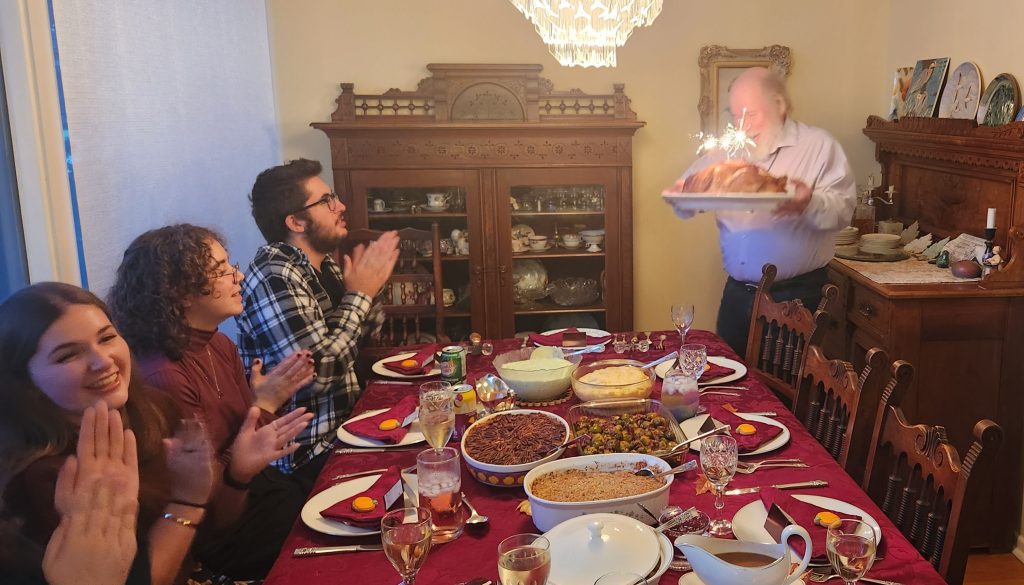Deasland
Where and what is Deasland? This is a place name that I have come across a number of times in my genealogy research, and each time there is a new connection to the Hubbard family history.
The first time I saw the name (sometimes spelled “Deaseland”) was on a census record for the Henry Mills family, near the tiny village of Rock, in Worcestershire, England. I was looking for Henry because one of his daughters, Elizabeth (1841-1925) had married Thomas Hubbard, a machinist, in 1869–they were Rob’s great-grandparents–and I hoped to find out more about earlier generations. Elizabeth and her numerous siblings were raised on the large farm of Deasland, a few miles from Rock, which had been in the family since at least her grandfather’s time and possibly earlier. Family members continued to live at Deaseland for several more decades, as evidenced in the census records of 1841 through 1871.


The original farmhouse, dating from the 14th century, is still in use today, with some additions and changes. It is a Grade II listed building, “an L-shaped half-timber and plaster two-story building with a central hall.” The second story was added in the early 17th century – the porch lintel has the date “1611” on it (from British History Online). It is still a working farm and occupied in spite of the wavy roof line!
It appears that Elizabeth’s brother, William Mills, put the farm up for sale in 1878, which agreed with the terms of his father’s will signed in 1874. This advertisement for the sale gives a lovely description of the whole property:

Where did the name come from? I have not found any information on the origin of the farm’s name, but a Professor Ekwall and a Mr Bruce Dickins agree in suggesting that the first element is OE d?aþ , used of ‘a dead person, a departed spirit,’ cf. B.T. Supplt s. v. The place was perhaps so named from being haunted. (Survey of English Place Names)
Immediately next door is a property known as Deasland House, a much-renovated and modernized two-story house, which was possibly originally part of the same farm complex. The article at British History Online mentioned there were two farmhouses, but this may also be a new build entirely. It was on the market in 1994 for £255,000.
This map snippet shows how close the two houses are:

Back to Elizabeth Mills who married Thomas Hubbard – her father’s sister (also named Elizabeth–just to keep things suitably confusing!) married William Harcourt and they had a large family. Their youngest son was George, born in 1842, just a year after his first cousin (our) Elizabeth.
George emigrated to Australia in 1860, together with his parents and quite a few siblings. He married in 1881 and in 1893, George built a homestead in Ginninderra, New South Wales and named it “Deasland” after the place where his parents had married, back in the UK. This homestead became quite famous as a successful sheep station and social hub.


A Wikipedia article provides more detail about subsequent owners and uses of this distinctive building located just outside the northern suburbs of Australia’s capital city, Canberra. Eventually, most of the land was sold off, buildings were demolished, and the extensive property was absorbed into the northern suburbs of Canberra. Unfortunately, just last year, the government ordered the demolition of the 130-year-old Deasland due to its asbestos insulation. An interesting short news clip about that can be seen on YouTube. Deaseland Place is a 1976 subdivision development close to the homestead in the suburb of Fraser.
Another house was named Deaseland, in Oxshott, Surrey, according to the Surrey Advertiser County Times of 16 November 1925; it was the home at that time of yet another Henry Mills, so it may well have been named after the original Worcestershire farm near Rock.
Once again, back to Elizabeth Mills who married Thomas Hubbard — they had three children all born in Birmingham, UK. The youngest of these, Sydney Tom, immigrated to Canada in 1893 and subsequently married Flora Fraser; these were Rob’s grandparents. They lived on a portion of Flora’s father’s original River Lot 28 in Edmonton, Alberta, just east of downtown, and in 1912 subdivided a portion of the land to be developed into housing. The proposed name for the neighbourhood was–that’s right– Deasland, as can be seen on this map at the red star:

The Deaseland neighbourhood name now exists only on old maps and advertisements, as that area of the city is known today as Highlands. The Hubbard home, situated at 7203 – 118 Avenue, was demolished to make way for Capilano Drive, now called Wayne Gretzky Drive, which runs roughly where the boundary line above separates Virginia Park from Bellevue.

Clearly, the original Deasland, the family seat, meant a lot to the widely dispersed family members, as it is honoured in so many different places around the world.


